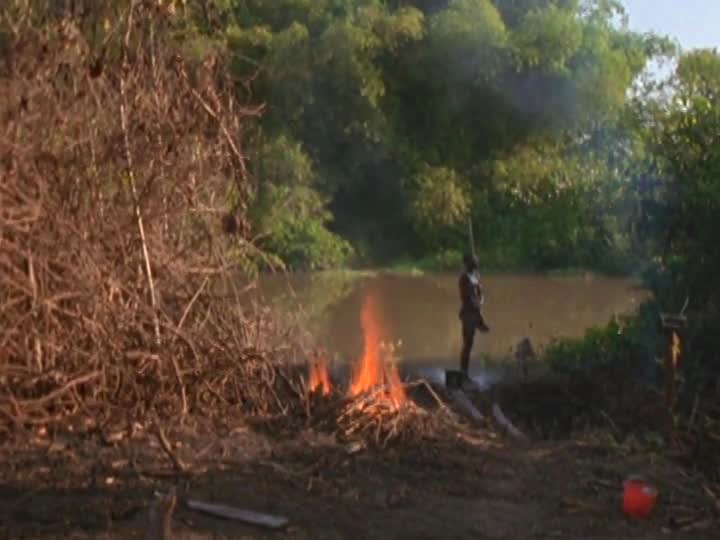The films of Ben Russell have been on my mind quite a bit this year. First, he toured a small retrospective of his recent work (including a double 16mm projector performance piece) around the globe, culminating in Los Angeles for a single night stop-over this past February. He then brought his newest film, A Spell to Ward off the Darkness, a collaboration with British experimentalist and kindred spirit Ben Rivers, to the Toronto International Film Festival where it stood out even amidst an incredibly diverse Wavelengths program. [Editor’s note: It plays AFI Fest this weekend.] Indeed, it remains one of the year’s most exhilarating theatrical experiences, as well as the impetus for this piece—a majority of people I spoke with at the festival, while familiar with Rivers, had little beyond name recognition of Russell. Soon after, in an essay here at Fandor on permutations in the modern music documentary, I impulsively highlighted one of his shorts, Black and White Trypps Number Three (2007), despite it bearing little in common with traditional aspects of the form. Among other things, Russell’s ability to navigate such disparate scenes speaks to his insatiable instinct to indulge various aspects of his personality while reinforcing his position as a contemporary renaissance artist. There is truly no one making films like Russell right now.
A graduate of Brown and later the Art Institute of Chicago, Russell has led an itinerant life, even spending time with the Peace Corps, reflecting the culturally diverse, anthropologically inquisitive work he has produced over the last decade-plus. He is most commonly associated with the ethnographic mode of filmmaking, an interest he has taken to unique ends in both his Trypps series, an ongoing excavation of the divide between the rhythmic and the ritualistic, as well as his feature-length Suriname expedition Let Each One Go Where He May (2009). But his catalogue is far more varied than the association implies. As mentioned, he has particular affection for the aural aspects of filmmaking and a predilection for music of both the minimalist and extreme varieties, often compressing the spectrum and finding a bridge between the two. He also has a flair for the absurd, even surreal, with many of his films building to hallucinogenic peaks. In either case, Russell is constantly in pursuit of the transcendent in the elemental, the sublime in the aleatoric. And in this way, he can feel like something of an heir to Jean Rouch and Bruce Conner alike.
Common critical record would suggest the introduction of the Trypps series as the dawn of Russell’s mature period. But many of his early films are amongst his most intriguing, while each evidence even in nascent form, themes, techniques, and idiosyncrasies that have carried well into his recent output. Crude endeavors such as The Death of Abraham Lincoln (in Three Parts) (1998-2000) and The Breathers-In (2002), while passionate creations, certainly remain formative, the work of an ambitiously budding filmmaker attempting to reconcile years of ideas, influences, and insights. From this mercurial confidence arose many of Russell’s most distinctive traits: His employment of manipulated voiceover narration (present in Terra Incognita [2002], The Tawny [2003], and The Red and the Blue Gods [2005]), his penchant for cultural and ahistorical rejoinders (The Death of Abraham Lincoln, Daumë [2000], The Twenty One Lives of Billy the Kid [2005]), to even his strange affinity for self-styled masks, from the keyed-up clown visage in Abraham Lincoln to the lawman-as-swine masquerade in The Breathers-In to the titular break dancing divinities in The Red and the Blue Gods. (One method that hasn’t made the transition? The director’s application of silent film aesthetics, which seem to have died out after his initial flourish.)
It’s better, then, to think of the Trypps series less as a rebirth and more as a refinement—or, at the very least, a narrowing of focus. Save for sister films The Quarry (2002) and Terra Incognita, two meditations on the temporal continuity of a natural and spiritual monument located on Easter Island, most of Russell’s early work careened through various impulses. Beginning with Black and White Trypps Number One (2005) and continuing on through today, one sees an uncommon focus and thematic dedication on the part of the filmmaker. No matter their hypnotic qualities, however, both Trypps Number One and Trypps Number Two (2006) feel like transitional pieces, monochromatic, in-camera experiments in disorientation, with the former progressing literally and figuratively as a static configuration while the latter inverses and mirrors its woodland image, wringing space out of an otherwise dense tableau. It’s with Trypps Number Three and Trypps Number Four (2008) where Russell’s aesthetic scale compresses into severe A/V experiences, as performances by Rhode Island-based noise rock duo Lightning Bolt and comedian Richard Pryor are, respectively, concentrated and sent oscillating mesmerically, both naturally inducing the trance-like state the project portends.
Since then, Russell has dispatched a few more Trypps entries, ranging from the placid neon fluorescence of Trypps #5 (Dubai) (2008) to the more subjective psychotropic representations of Trypps #7 (Badlands) (2010). In between he has made what are arguably his most substantial works yet. His feature-length debut, the aforementioned Let Each One Go Where He May, injected a formal ingenuity into his previously intuitive methodology, presenting thirteen single-take documentations of rural and indigenous energy as two brothers are seen travelling through a South American topography pulsing with activity both lulling and vibrant. One final authorial stroke on the part of Russell during the film’s penultimate scene—a feverish display of tribal mythology splashed with the director’s trademark grotesqueries—collapses the divide between narrative strands once thought to be of single accord (It’s a segment so standalone brilliant that Russell excised and presented it in slightly extended form as the sixth Trypps short).
Soon after, River Rites (2011) would emerge as equally fully formed, and while not nominally a Trypps entry, is certainly spiritually of a piece with the greater enterprise. Another bravura single-take symphony of human movement, and soundtracked by another self-explanatory avant rock troupe, Mindflayer, the film literal reverses coordinates, sending bodies hurtling backwards in an arcing, synchronized dance of rhapsodic mobility. Meanwhile, both Ponce de León (2012) and A Spell to Ward off the Darkness would initially seem to be forgoing movement in favor of reflection. And while these films do indeed take a more introspective approach, they do so in subtly dynamic fashion, as Russell builds movement, not to mention textual weight, into the compositional framework of the former, while accumulating tension through the seemingly disparate segments of the latter, before building to a musical climax that plays at once as physical exhibition and spiritual exorcism (for more on A Spell to Ward off the Dark specifically, see Michael Sicinski’s piece here in Keyframe; and I also wrote about it from TIFF). The thematic preoccupations of these recent films can thus be read as something of a microcosm of Russell’s cumulative career: The out of body representations of Let Each One Go Where He May and River Rites, as well as the internalized emotional gradations of the explorers in Ponce de León and A Spell to Ward off the Darkness, all working toward what has been described as the director’s embodiment of our eternal everything. But if this is fate, so be it; Russell seems dangerously close to reaching nirvana.






